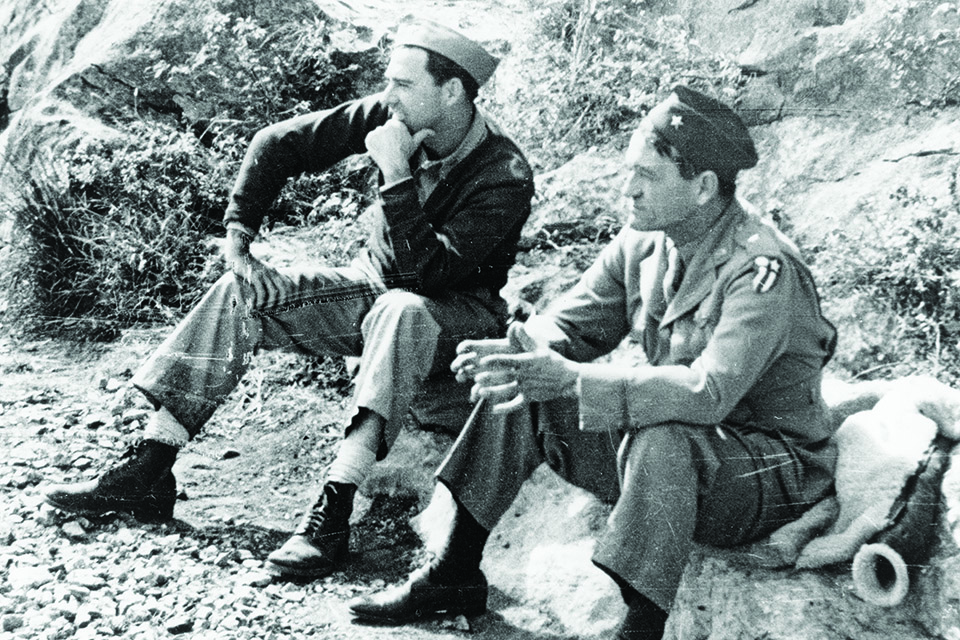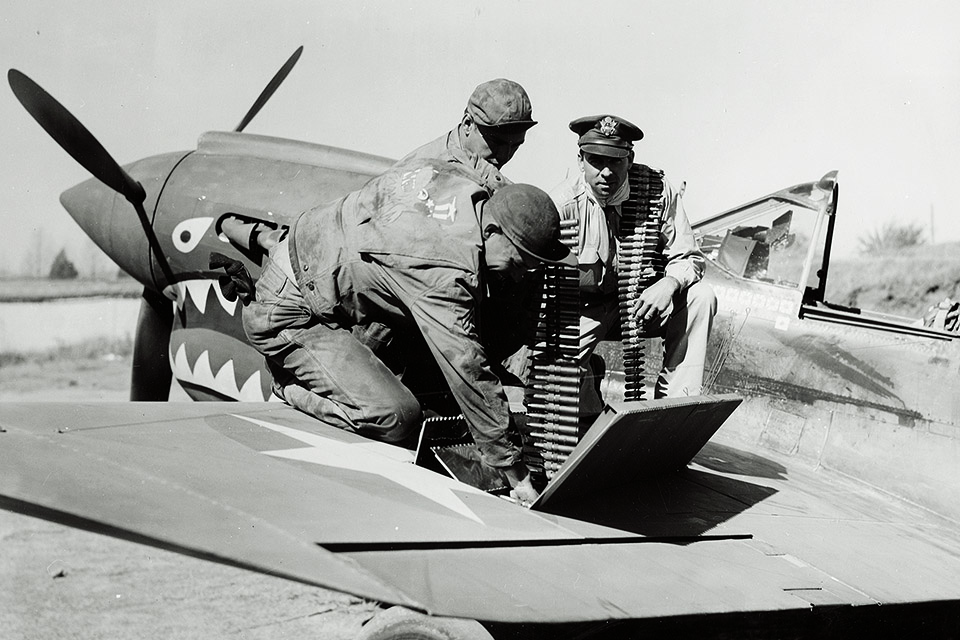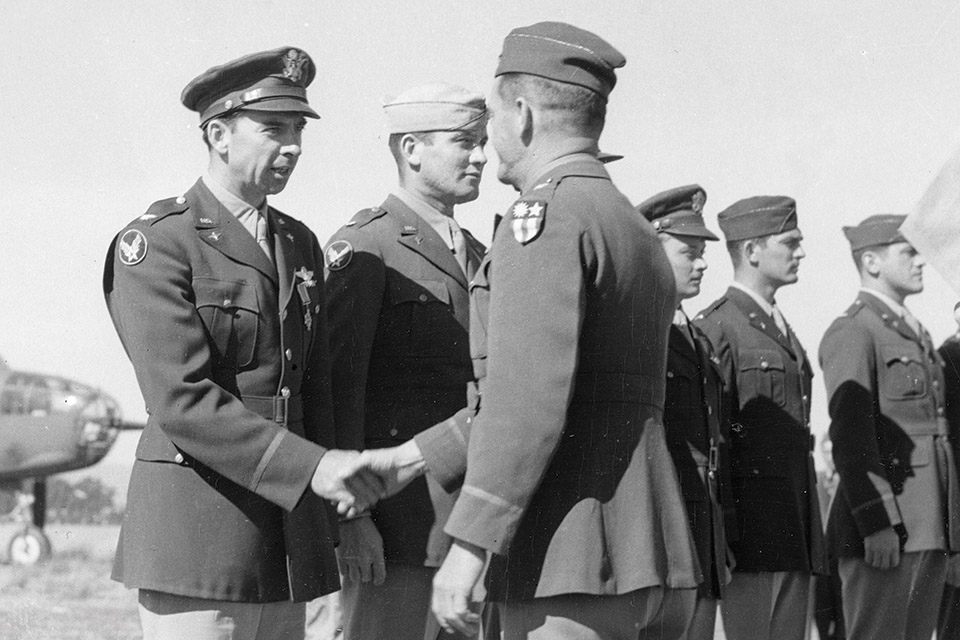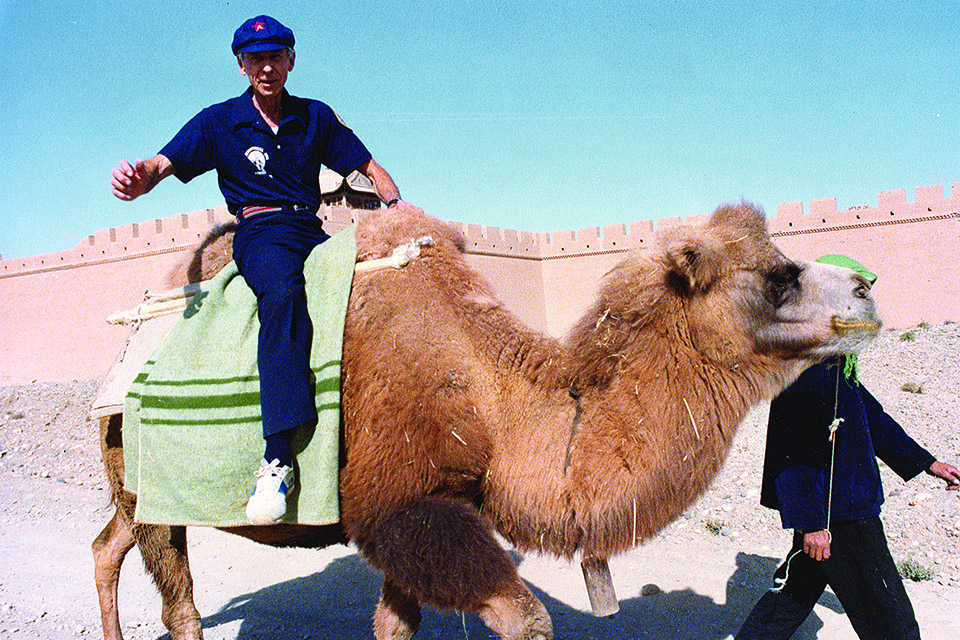In 1943 General Henry H. Arnold’s secretary buzzed his inner sanctum, informing the U.S. Army Air Forces chief, “Colonel Scott is here, sir.” “Hap” Arnold, who lived in a frequent boil, replied, “Oh, you mean God’s personal pilot?”
Colonel Robert L. Scott Jr., fighter ace and bestselling author of God Is My Co-pilot, was in trouble…again. He had just offered to strafe John L. Lewis, the mine workers’ union boss who had continually violated the wartime “no strike” pledge after Pearl Harbor. Called upon Arnold’s thick carpet, Scott said, “General, I was only expressing my personal opinion.”
Arnold came out of his chair, red-faced, finger jabbing. “Damn it, Scott! When you wear that uniform you don’t have a personal opinion!”
At McDill Field in Florida, Scott’s younger brother Roland was going through B-26 Marauder training. His copilot noted the news reports and said, “Well, your brother’s never going to be a general now!”
Long after, Bob Scott quipped, “I think that’s when General Arnold began looking for a way to send me back to combat where I could get killed.”
Combat pilot, bestselling author, big game hunter, versatile chef and incomparable raconteur—Scott was all those and more. Reared in Macon, Ga., he was also among the last cavaliers of the Old South. He made his final flight west from Georgia on February 27, 2006.
Born on April 12, 1908—almost 43 years to the day after Robert E. Lee’s surrender—Scott was steeped in Georgia’s history and staunchly proud of his Southern roots, but he grew into an unabashed patriot and warrior for the United States. Following graduation from West Point, he received his wings in October 1933 and spent the next eight years preparing for war. Scott survived the brutal winter of 1933-34, when President Franklin D. Roosevelt ordered the Army to fly the mail, resulting in numerous crashes and the death of 13 airmen. Seeking more time with his girlfriend in Georgia, he arranged to swap routes with another pilot, 2nd Lt. Curtis LeMay.
Scott loved to fly as few ever did. He was accused of being a “time hog” and probably never denied it. Somehow, in the Depression-strapped Air Corps, he averaged well over 400 hours per year when airmen were allotted only 48. In his enthusiasm, he earned the enmity of his first commanding officer by using up the squadron’s authorized hours in his first month.
Yet there was purpose to Scott’s passion. As he explained to his wife, Kitty, “If Paderewski practices the piano 12 hours a day, and a ballerina practices 12 hours, and they are the best, then I have to fly as many hours a day as I can if I’m to be the best fighter pilot.”
One way of building up flight time was instructing, and Scott got plenty at Texas’ Randolph Field in the 1930s. Remaining in training command, in 1939 he moved to Cal-Aero Academy at Chino, Calif., the largest flying school in the country. During his tours in Texas and California, he logged more than 2,000 hours instructing Army cadets, and he commanded the sprawling Chino base when the Japanese attacked Pearl Harbor. But he was absolutely determined to get into combat, by any means possible.
Bob Scott was a fighter pilot, with a chip on his shoulder and a gleam in his eye. He wrote of the chips that he and other “pursuiters” carried: “They have to be there—arrogant, egotistical chips mellowed by flying technique and experience and fortified by the motto ‘Attack!’”
At age 34, however, Scott was considered too old for combat and had to tell a couple of lies (“And not little white ones, either,” he admitted) to get into the war. Among other things, he claimed expertise in the B-17 though he had never flown one. In February 1942, he joined a B-17 task force sent to India to bomb Japan from China. But when that mission fell through, he took the next best job, flying C-47 transports from India to China across the Himalayan “Hump.”

By the time he finally got into combat in April, Colonel Scott had logged nearly 5,000 hours, likely a pre-combat record among American aces. Having impressed Brig. Gen. Claire Lee Chennault with his ability and enthusiasm, he was chosen to command the brand-new 23rd Fighter Group. He was in his element, flying Curtiss P-40 Warhawks with three squadrons of young hotshots a decade junior to him.
Scott and the other pilots benefited from a handful of Chennault’s American Volunteer Group “Flying Tigers” who stayed on to provide the Army fliers with invaluable combat knowledge. One of the 23rd’s squadron commanders, AVG ace David Lee “Tex” Hill, described Scott’s leadership style: “Bob said, ‘Put me on the board for all the big ones until I say different.’ I don’t think he ever took his name off the board.”
Wounded on his first mission as group commander, Scott returned with steel shards in his back, the result of Japanese gunfire hammering his P-40’s armor plate. He was escorted to a cave overlooking Kweilin Airfield, where Dr. Fred Manget, an old China hand, tended to him. With no anesthetic, Scott endured the pain as the medical missionary extracted the splinters.
During the prolonged process, Manget’s Chinese aide asked Scott, “Colonel, you fly plane, shoot guns, talk radio, all time fight barbarian. You do all these things alone?”
Biting down the pain, Scott snapped back: “Where in hell would anybody else sit? No, I don’t need any help. I’m a fighter pilot!”
Dr. Manget interrupted his alcohol swabbing to confront his patient, eye to eye. “You’re wrong there, son,” he said softly. “You are never alone up there. Not with all the things you came through. You have the greatest copilot in the world even if there is just room for one in that fighter ship.”
When he sat up, Scott reeled figuratively and literally. He visualized illuminated figures dancing on a black velvet screen. They resolved themselves into a phrase: “God is my copilot.” A title had revealed itself before a book ever took shape. Oddly, however, he didn’t include that episode in his famous book.
Scott notched his first victories near Leiyang on July 31, claiming a bomber and a Zero (though it was probably a Ki-43 Oscar army fighter, since no Japanese naval fighters were active in the area). Less than two months later he realized his childhood ambition of becoming an ace when he downed his fifth plane, a Ki-45 Nick at Gia Lam Airport near Hanoi.
One of Scott’s most gratifying missions was the Thanksgiving 1942 attack on White Cloud Airdrome at Canton. Among his mentors was Colonel Merian Cooper, the World War I flier and director of King Kong who served on Chennault’s staff. Cooper, riding in a B-25 Mitchell, had asked Scott as fighter leader to allow him a shot at an enemy aircraft. Scott was credited with two Ki-97s (actually Ki-27 Nate fighters) to make double ace, chasing one within range of Cooper’s bomber. Afterward Cooper expressed gratitude for the opportunity, though Scott kept the truth to himself—he’d barely chased down the Nate before Cooper could shoot. The group commander closed his victory log over Christmas 1942 with Type 97 bombers (Ki-21 Sallys) on the 24th and 26th.

Scott’s victory score has been reported between 10 and 22. He said that before returning Stateside in January 1943, Chennault gave him an affidavit attesting to the higher number, though Scott never claimed more than 13 destroyed. His official tally was reduced to 10 in the 1970s, plus five probables and three damaged. In any case, he left China as the Army Air Forces’ leading ace in the China-Burma-India Theater.
Upon his return to the U.S., Scott was recruited into the AAF public relations machine. One result was his smash bestseller about his war experiences, suggested by a publisher friend and “written” in a matter of days. As Scott explained, he dictated the book while holed up in a New York hotel. His dictograph disks were delivered to Scribner’s each day for transcribing by “a tin-eared Yankee secretary.” Whatever the process, it was dipped in pixie dust. The first printing sold out almost immediately, and Hollywood quickly came knocking. Scott was assigned to help with the filming, flying a P-40N in several sequences, but he was chagrined when Jack Warner said, “Son, forget the manuscript. We’d have paid you as much just for the title!”
Scott approved of casting the dignified Raymond Massey as Chennault, but Warner Bros. wanted a big name for the leading role. When his mother, who didn’t approve of alcohol, heard that Humphrey Bogart was being considered, she put her foot down. After all, Bogie had played a saloon keeper in Casablanca. Mr. Warner would just have to find another actor—and he did. Dennis Morgan got the nod.
Scott was embarrassed by the screenplay, especially Richard Loo’s loquacious enemy ace, “Tokyo Joe.” The bestselling author fervently wished he could have ducked out of the premiere in Macon.
Co-pilot was one of the few memoirs published during the war that remained in print more or less permanently thereafter. Scott didn’t know how many million copies were produced up to the 1980s, but he did appreciate the book’s enormous influence. He received copies for signing for decades, from schoolboys to Air Force officers.
Finally relieved of PR duties in 1945, Scott was more than ready to get back to the war. He had been impressed with the latest aviation ordnance, high-velocity aircraft rockets (HVARs), and determined that Chennault needed them.

With his Southern charm, Scott could convince almost anybody of anything. Lest anyone doubt it, consider that he coaxed thousands of high-priority weapons from the U.S. Army’s bitter rival, the U.S. Navy.
When he finally got approval to return to combat, Scott made friends with a boisterous naval aviator who, if possible, matched the Southerner’s colorful personality. Captain “Jumpin’ Joe” Clifton was legendary—allegedly the only Navy pilot who did not need a radio for communication. Between them, Captain Clifton and Colonel Scott wrested perhaps 100,000 HVARs from the clutches of Naval Ordnance and arranged to ship them to China. Scott took them from there, touring with an HVAR instruction team that taught Fourteenth Air Force pilots how to use them. Scores of Japanese locomotives were derailed thanks to Scott, Clifton and a rare example of interservice cooperation.
Later based on Okinawa, where he flew some anti-shipping strikes, Scott related his view of the Japanese surrender ceremony in Tokyo Bay on September 2, 1945. He described flying his P-51 Mustang and looking down on the immense gray edifice that was USS Missouri, musing upon the Stars and Stripes flying from its mast. But the Georgia rebel was never far beneath Scott’s skin, and that gray morning he cracked open his canopy to unfurl the Confederate Stars and Bars in tribute to his fellow Southerners who had helped achieve victory. They included the maverick Claire Chennault, who had been denied a place among the victors on “Mighty Mo’s” deck that morning.
Toward the end of the war, Scott was astonished to learn he owed the U.S. government $25,000 in back taxes—on a colonel’s pay! Co-pilot had accumulated tremendous royalties that had not caught up with him, but Uncle Sam’s accountants knew the amount to the penny. Undeterred, Scott continued writing. His book production included a dozen titles over a 45-year period.
In his first postwar assignment, Scott took command of Williams Field in Arizona, where he transitioned to jets. One of his “Willie” crew chiefs remembered him as “a colorful and popular commander.” Retired Master Sgt. Ken Tomb said, “He always had time to talk with us, unlike some other famous pilots I could mention.”
Scott spent the Korean War commanding an F-84 Thunderjet wing in Germany. He would much rather have been chasing MiGs over the Yalu River, but his fertile imagination soon conjured up a plot straight out of a novel. In fact, the storyline—about a plan to hijack a MiG from behind the Iron Curtain—became the basis for his 1955 novel, Look of the Eagle.
Scott’s daughter, Robin, being an Air Force brat, recognized her father’s unusual career track. At one point she asked, “Aren’t they ever going to make you a general?” When Scott finally pinned on his star in 1954, he had been a colonel for 13 years.
Following Scott’s retirement from the Air Force in 1957, he and Kitty settled in Phoenix, where he embarked on a second career in insurance. Kitty died in 1972, but Scott continued writing and, especially, traveling.
In the 1970s Scott decided to complete a trek that had been interrupted by the war. On his graduation leave from West Point, he had taken a motorcycle trip along Marco Polo’s fabled “Silk Road,” reaching the western end of the Great Wall of China. From the air he had followed the wall’s meandering course several times during the war, but he yearned to travel the length of it on the ground.

Ignoring repeated rebuffs, Scott wrote 300 letters to officials in the U.S. and China and, at age 72, he fetched himself to the People’s Republic. There he completed the nearly 2,000-mile odyssey by various means: on foot, by rail, yak and camel. En route he sustained himself with 1,200 oatmeal raisin cookies he had baked. Later he sent friends a photo of himself astride a Bactrian camel beneath the Great Wall, wearing a smile and a Chairman Mao cap complete with red star.
Chiang Kai-shek would have been appalled.
In the late 1980s Scott returned to his roots in Macon, where he took on his final challenge. Scott, a tremendous fundraiser, devoted the last several years of his life to supporting the Museum of Aviation near Warner Robins Air Force Base. In 1998 a 1,700-square-foot exhibit hall was dedicated to his career.
Scott also helped carry the Olympic torch through Macon in 1996 on its journey to the Atlanta games. And he jogged rather than walked. After all, he was only 88.
Scott died two months shy of his 98th birthday, breaking the record for the oldest living American ace. (World War I pilot James W. Pearson was 97 years and nine months when he died in 1993.) His decorations included two Silver Stars, three Distinguished Flying Crosses and three Air Medals.
Longtime friends recalled the contradiction that was Bob Scott: the soft Southern accent, the genteel manners, the predator’s blue eyes. China veterans mused that the one consolation attending his death was that he was once more with most of those he knew in Asian skies: Claire Chennault, Merian Cooper and so many others.
Robert Lee Scott Jr. is buried in Arlington National Cemetery, within sight of the Custis-Lee Mansion. Surely General Lee would have approved. In the rarified atmosphere far above the contrail level, perhaps he welcomed another Southern gentleman home.
Author Barrett Tillman met Brig. Gen. Scott in 1966 and corresponded with him for more than 20 years. Scott traveled from Phoenix to Oregon to speak at Tillman’s high school graduation ceremony in 1967. For further reading, try Scott’s latter-day memoirs: God Is Still My Co-pilot and The Day I Owned the Sky.






